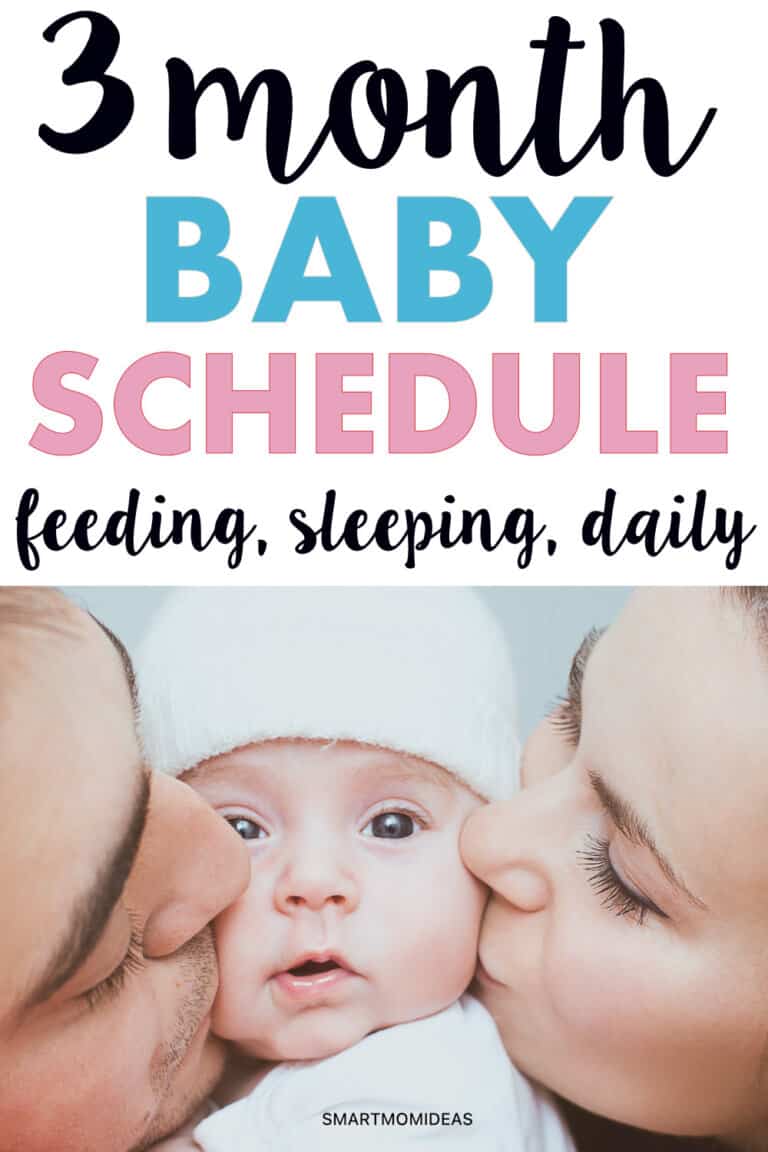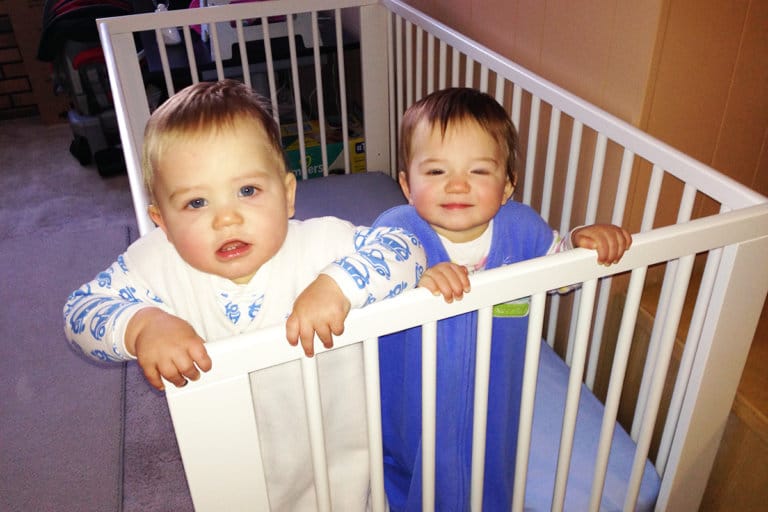Get the guide to the 3 month old schedule for your baby!
When babies are around 3 months old, they start to develop more predictable patterns in their daily lives.

While this may seem like a blessing, a typical 3 month old schedule may not work in harmony with yours!
I have twins, so trust me when I say that babies don’t always sleep and eat when it’s convenient for you – and they certainly don’t coordinate their schedules when there’s two of them!
But that doesn’t mean you can’t establish a healthy routine for your little one and figure out a schedule that works for everyone.
So let’s take a look at the essential elements of a typical 3 month old schedule, including feeding, sleep, naps, and breastfeeding, as well as a sample schedule to help you navigate this exciting phase of your little one’s life.
I’m going to mention this a few times, but keep in mind that all babies are different.
So just because one 3 month old schedule works for someone else’s baby doesn’t mean it will work for you.
But by being flexible and adaptable, you will find a schedule that works for your little one!
3 Month Old Feeding Schedule

Creating a structured and balanced 3 month old eating schedule can help ensure they receive the nutrition they need while fostering healthy eating habits as they grow.
Here’s what you need to know about creating and implementing an appropriate eating schedule for your little one:
1. Breastfeeding or Formula Feeding
At three months old, breast milk or formula continues to be the primary source of nutrition for most babies.
Both breastfeeding and formula feeding have their own benefits, and it’s important to choose the feeding method that works best for you and your baby.
For a 3-month-old breastfeeding schedule, aim to nurse your baby approximately every two to three hours during the day.
Breast milk is easily digested, so frequent feedings are necessary to meet their nutritional needs and support their growth.
Similarly, if you are formula feeding, follow a 3-month-old formula feeding schedule that includes feedings every two to three hours.
Formula provides the necessary nutrients for your baby’s development, and spacing out the feedings ensures they receive adequate nourishment throughout the day.
3. Recognizing Hunger Cues
It’s crucial to pay close attention to your baby’s hunger cues, as they serve as their primary means of communication with you.
Being attuned to these cues will help ensure that you respond promptly to their needs.
Look out for signs such as rooting, where your baby turns their head toward the breast or bottle, as well as sucking on their hands or fingers, or making sucking noises.
These instinctive behaviors indicate that your baby is ready to eat and should not be ignored.
By recognizing and responding to these hunger cues, you can establish a feeding schedule that meets your baby’s nutritional needs and supports their healthy growth and development.
4. Feeding on Demand vs. Scheduled Feedings
While it’s important to establish a general feeding schedule, it’s equally important to be flexible and responsive to your baby’s needs.
Some babies may naturally fall into a more predictable feeding routine, while others may prefer feeding on demand.
With my twins, I did put them on a schedule and fed them both at the same time throughout the day.
Feeding on demand means offering feedings whenever your baby shows signs of hunger, regardless of a set schedule.
This approach allows your baby to guide their own feeding patterns and ensures they receive the necessary nutrition for their growth and development.
On the other hand, scheduled feedings involve following a predetermined routine where you offer feedings at set intervals throughout the day.
This approach can provide structure and predictability for both you and your baby, making it easier to plan your daily activities.
Sleep Schedule for 3-Month-Old

As your baby grows, their need for quality sleep becomes increasingly important.
At around three months old, babies typically develop more distinct sleep patterns, which can greatly impact their overall well-being.
Understanding your baby’s sleep needs and creating a soothing sleep environment is essential for promoting healthy sleep habits.
Establishing a consistent sleep schedule for your 3-month-old is key to ensuring they get the rest they require for optimal growth and development.
Here are a few tips to help you create a consistent sleep schedule:
- Observe your baby’s cues: Pay attention to your baby’s signals for tiredness, such as rubbing their eyes, yawning, or becoming fussy
- Set a regular bedtime: Establishing a consistent bedtime routine can signal to your baby that it’s time to relax, wind down, and prepare for sleep.
- Create a soothing sleep environment: Make your baby’s sleep space comfortable and conducive to sleep.
- Implement a consistent wake-up time: Encourage a regular wake-up time in the morning to set the tone for the day.
By establishing a consistent sleep schedule for your 3-month-old, you are not only promoting healthy sleep habits but also providing them with a sense of security and routine.
Again, every baby is different, and different routines work for different babies.
With time and patience, you’ll find a sleep schedule that supports your baby’s well-being and contributes to a harmonious daily routine.
3 Month Old Nap Schedule Naps

Along with sleeping at night, naps play a crucial role in your 3 month old baby’s development and can greatly impact their mood and behavior.
Establishing a consistent nap schedule tailored to your baby’s individual needs can help ensure they get the rest they require to thrive.
To create a 3 month old nap schedule that suits your little one, follow a pre-nap routine.
Establishing a pre-nap routine can help signal to your baby that it’s time to wind down and prepare for sleep.
This can include activities like reading a story, singing a lullaby, or gentle rocking. Consistency in the routine will help your baby associate these actions with naptime.
Also, find the right nap duration.
While every baby’s sleep needs are different, a typical 3 month old baby may take three to four naps throughout the day, each lasting around 1 to 2 hours.
However, you may have to be flexible with naptimes and adapt to your baby’s needs. Some babies may require shorter or longer naps.
3 Month Old Daily Schedule

Now that we’ve covered the different aspects of a schedule for your 3-month-old, let’s dive into creating a structured daily routine that’s both practical and comforting!
A well-planned schedule is key for your little one at this stage. It brings a sense of predictability and comfort to their day, and it can work wonders for you too!
By incorporating activities, feedings, and sleep times into a balanced routine, you’ll find a rhythm that suits your baby’s needs and your own.
Start by considering your baby’s natural patterns and preferences. This will help you identify the best times for feedings, naps, and play.
Begin the day with a consistent wake-up time to help regulate their internal clock. After waking up, change their diaper and create a nurturing and soothing environment to ease them into the day.
When it comes to feedings, a 3-month-old typically eats every three to four hours, but remember that each baby is different.
In between feedings, engage your little one in playtime and interactive activities.
Tummy time, gentle exercises, singing, reading, or exploring age-appropriate toys are all great ways to stimulate their cognitive and physical development.
Naptime is crucial for your baby’s growth and well-being, so aim for regular intervals throughout the day to ensure they get the rest they need.
As the day progresses, stick to the established routine while remaining flexible.
Your baby’s needs may change from day to day, so be prepared for additional feedings, extra naps, or shorter play sessions.
In the evening, establish a calming bedtime routine.
Reading a bedtime story, enjoying a warm bath, giving a gentle massage, or singing a lullaby are all soothing activities that signal it’s time to wind down and prepare for a good night’s sleep.
Remember, while a schedule provides structure and guidance, it’s important to be flexible and adaptable.
Every baby is unique, and their needs can vary.
Creating a structured daily routine for your 3-month-old brings predictability and comfort to their life, promoting their overall well-being.
Observe your baby’s cues, adjust the schedule as needed, and cherish this special time together as you navigate the joys of parenthood.
Sample 3 Month Old Schedule
Okay, so we’ve talked about all kinds of 3 month old schedules and how to create one – now let’s take a look at a sample 3 month old schedule:
- 7:00 AM Wake-up and Diaper Change: Gently wake your baby and start the day with a diaper change to keep them clean and comfortable.
- 7:30 AM Feeding: Begin the day with a feeding session, whether you’re breastfeeding or bottle-feeding. This helps satisfy your baby’s hunger after a night of sleep.
- 8:30 AM Playtime and Interaction: Engage your baby in stimulating playtime and interactive activities. This is a great opportunity for bonding, talking, singing, and introducing toys or colorful objects to stimulate their senses.
- 9:30 AM Naptime: By this time, your baby may start feeling sleepy. Create a calm and soothing environment to encourage a restful nap. Dim the lights, use white noise if helpful, and ensure their sleeping area is safe and comfortable.
- 11:00 AM Feeding: After waking up from their nap, it’s time for another feeding session. Pay attention to your baby’s hunger cues and ensure they are getting adequate nourishment.
- 12:00 PM Tummy Time and Sensory Play: Encourage your baby to spend some time on their tummy, which helps strengthen their neck and upper body muscles. Additionally, introduce sensory play with age-appropriate toys or objects to further stimulate their development.
- 1:30 PM Naptime: As midday approaches, your baby will likely need another nap. Follow the same steps as the morning nap to create a peaceful sleep environment.
- 3:00 PM Feeding: Wake your baby gently for their next feeding session. Offer them the breast or a bottle to satisfy their hunger and promote healthy growth.
- 4:00 PM Stroller Walk or Outdoor Time: Take advantage of the afternoon by going for a stroller walk or spending time outdoors. Fresh air and a change of scenery can be refreshing for both you and your baby.
- 5:30 PM Naptime: As the day progresses, your baby might start showing signs of tiredness again. Allow them to take a short nap to recharge before the evening.
- 7:00 PM Feeding and Bedtime Routine: Begin the evening routine with a feeding session, which can be followed by a relaxing bath or gentle massage to prepare your baby for bedtime. This routine signals to your baby that it’s time to wind down.
- 7:30 PM Bedtime: Create a calm and peaceful environment in the nursery, ensuring the room is dimly lit and quiet. Put your baby to bed, providing them with comfort and security for a restful night’s sleep.
This sample schedule is a guideline, so it’s essential to adapt it based on your baby’s individual needs.
As you observe their behavior and cues, make adjustments to the schedule to accommodate their feeding, sleeping, and playtime preferences.
Flexibility and responsiveness to your baby’s needs will help you create a routine that works best for both of you.
Embrace the Journey: Creating a Nurturing 3-Month-Old Schedule
Establishing a 3-month-old schedule can bring a sense of stability and routine to your baby’s life while allowing you to better plan your day.
Remember, flexibility is key, as every baby develops at their own pace.
By following the tips and suggestions in this practical guide, you can create a schedule that suits your baby’s unique needs, fostering their growth, development, and overall well-being.
Enjoy this special time with your little one as you navigate the joys and challenges of parenting together!
Now it’s your turn – What strategies have you found most helpful in establishing a schedule for your 3-month-old? I’d love to hear about your experiences and insights in the comments below!




Leave a Reply